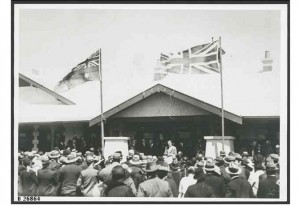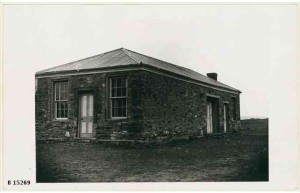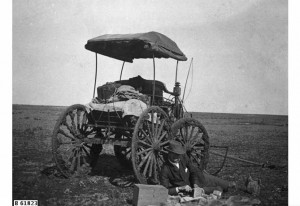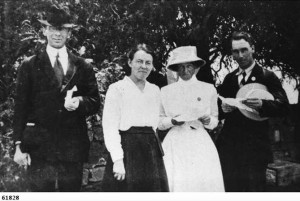Causes of death
Local cemeteries often give a good idea of how people died in the years before there were hospitals, immunisations and drugs
– Children often died young.
– In summer:
- water supplies were low and often the water carried disease
– especially when the same water supply was used for washing and drinking.
- Meat could not be kept cool properly and there was very little fresh food. Flies were everywhere.
– There was no rubbish disposal service and no sewerage.
Quorn, July 1879, Report of discussion at Public MeetingThe filthy condition of the street between the hotels was next discussed, and Dr. Creelman stated that unless some steps were taken to prevent further accumulation of foul matter very serious consequences would result to all living hard by, and perhaps to the whole population. He considered the sanitary authorities should be communicated with in order to secure the abatement of the nuisance. A desultory discussion followed, in which attention was drawn to the fact that the locality was at present without a slaughtering reserve, the consequence being that animals were killed in various places, and even in the township itself. Nothing definite was, however, done regarding these subjects. |
– In winter, colds and flu, bronchitis and pneumonia all took their toll.
– Anything that involved having an infection or a temperature could lead to death before there were antibiotics and drugs like paracetamol that control temperature.
– Young men died when their horses fell, crossing swollen streams and other accidents.
– Women died in childbirth.
– At Mt Serle, where there was a ration depot, fifteen Adnyamathanha people died of measles in 1902.
Medical care
– Medical supplies were almost non-existent and there were no doctors or hospitals in the early years.
– The first hospital, provided by the government at Port Augusta in 1875, took in the seriously sick and injured from the inland and the northern settled areas.
- In 1913, a young station hand rode a bicycle 150 km from Norning Station to Port Augusta to fetch a bottle of medicine, and then 150 km back – all within 24 hours – Women worked as midwives, delivering and caring for children. – Doctors didn’t come till towns were relatively well established.
- Hawker had a resident doctor from the early 1880s.
- Quorn’s first doctor set up practice in the early 1900s, more than twenty years after the town was founded.
Hospitals
- A first step towards having a hospital was often taken privately by committed individuals or church missions.
- Mrs Lucy Ward and her daughters ran a licenced maternity home in Hawker from the late 1890s until 1928. Many women travelled long distances to be cared for here.
- Mrs Brewster opened ‘Hartley Lodge’ in Quorn in 1923. Two nurses cared for patients here working for Mrs Brewster until she died in 1937.
- Then a community Board of Management took over the premises and it became the town hospital. Quorn hospital was an important health service during World War II.
– Communities raised money for hospitals too. After World Wars I and II they were often part of the town’s war memorial effort, and received some government funding.
– Hawker and District Great Northern Memorial Hospital was opened by the Premier in 1924. It had 14 rooms and an x-ray machine. Returned soldiers were treated at a special rate.

State Library of South Australia B26864. There was a grand turn out at the opening of the new hospital in Hawker, 1924.
St John Ambulance Brigade began in Quorn in 1970.
Dentists
Dentists were few and far between. Syd Cocks, a Port Augusta-based dentist, was well known in the Flinders. Between 1927 and 1949 he drove (at high speed) to Wilmington, Quorn, Orroroo, Hawker and Marree to care for patients. Some farmers preferred not to bring their sheep through the Pichi Richi Pass on Tuesdays – this was the day that Syd Cocks drove from Port Augusta to tend to teeth in Quorn and then drove back at night (Quorn 1978:179).
Smith of Dunesk Presbyterian Mission Beltana
This mission was established at Beltana in 1894 to bring religious services to the miners, railway employees and people who lived on the scattered stations.

State Library of South Australia B15269 Building used for church services. This building became the Smith of Dunesk Mission church in Beltana. Date: about 1897
– Reverend Robert Mitchell was the first missionary at Beltana.
– He and later missionaries travelled by horse and buggy or train around the huge mission district, which stretched as far north as the rail head at Oodnadatta, nearly 600 km away.
– Late in his life, Mitchell returned to Beltana to serve again for a few months in the mission

State Library of South Australia B61823 ‘BELTANA: Reverend Robert Mitchell, agent for the Smith of Dunesk Mission at Beltana, taking a rest beside his mud caked buggy cart vehicle’ on his first posting to the mission. Date: about 1897
Mission based medical services: Beltana and Beyond
– The Beltana mission played a key role in providing medical, as well as spiritual, services for people living in the remote areas of the Flinders and the Outback.
– In the early twentieth century, there was growing awareness of the need to provide health care services for people living in remote areas.
– The District and Bush Nursing Society began then. – So did the Australian Inland Mission, which was headed by John Flynn.
– Flynn volunteered as a young man for appointment to the Smith of Dunesk Mission in 1911 and served there 18 months.
– The mission had placed a nursing sister and planned a nursing hostel at Oodnadatta, which Flynn brought to completion.
– From Beltana, Flynn was posted to the Northern Territory (1912), where his work with the Australian Inland Mission led to the creation of the Flying Doctor Service in 1928.
– The fifth missionary at Beltana, Rev. F.W. Rolland, lobbied for a nursing service for the people in the inland. He succeeded in having a nurse (Alice Main) appointed to Oodnadatta in 1906. Her huge district included Marree, 320 km away.

State Library of South Australia B61828. John Flynn (left), Presbyterian minister, founder and superintendent of the Australian Inland Mission photographed with Sister Kinnear, Elsie Coultas, and the Reverend J. Armour at Beltana.
Nursing Sisters
– In 1912, the District Trained Nursing Society appointed Sister Winifred Howie to Marree to open a cottage hospital.
– Another branch was opened in Farina in 1921. When the first hotel closed in Farina in 1925, it was turned into a hospital and used for many years.
– Back at Beltana, the AIM established a nursing hostel in 1919, which ran until 1955. The two nurses there then went to Radium Hill.
| Reg Sprigg wrote about the AIM sisters: The sisters were a rugged breed. They, too, had to endure dust-storms, negotiate floods and camp where they could in the harsh bush, mostly with only bread and dry beef and billy tea to succour them. They mastered horse-riding, swam swollen rivers and improvised stretchers and splints out of the handiest trees. They baked bread, organised bush parties, made strangers welcome and tended unstintingly the injured and the afflicted’. Sprigg, Reg C. 1984. Arkaroola-Mount Painter in the Northern Flinders Ranges, S.A.: The Last Billion Years p. 64. Arkaroola: Arkaroola Pty. Ltd. |
Beltana Missioners Plowman and Gray R.B. Plowman
– Plowman followed Flynn at Beltana, and transferred to the Australian Inland Mission at Oodnadatta in 1913.
– He travelled far into the Northern Territory by camel, and in June 1914 conducted the first service held in Alice Springs.
– He was the first to hold regular and organised church activities in Central Australia. – Wrote the books on his experiences in the Flinders and outback – the Boundary Rider, Camel Pads and The Man from Oodnadatta.
– Hans Mincham wrote about them: ‘The books not only cover his A.I.M. and missionary work; they present a faithful, historically valuable picture of Australians of two generations ago, and their way of life’ (Mincham 1965, p. 292).
William Gray 1924-1928
– Gray arrived at Beltana in 1924 when he was 70.
– For the first 18 months he travelled the district in horse and buggy – and then bought a Ford car. – He claimed to be a ‘fairly expert driver and a pretty fair mechanic’. When he drove Beltana, he had only been driving for 3 weeks and was 72. [Download Gray’s Journey to Beltana 1925]
– Gray often received requests from the south for accommodation and care for tuberculosis sufferers who might benefit from the warmer, drier air of the north. He turned the manse (the minister’s house) into convalescent home, secured vacant houses and even used tents to
accommodate sufferers.
– The Angorichina Hostel for tuberculosis sufferers was opened in 1927 – less hot and dusty than the western plain.
– Gray wrote Days and Nights in the Bush about his experiences in the bush – another wonderful historical source.
Resources for Health
- Australian Dictionary of Biography http://adb.anu.edu.au/biography/
- Mincham, Hans 1980. Hawker … Hub of the Flinders. Hawker Centenary Committee. Adelaide.
- Mincham, Hans, 1965. The Story of the Flinders Ranges. (Rev. Ed). Adelaide, Rigby • Mincham, Hans 1983. The Story of the Flinders Ranges. (3rd ed). Adelaide, Rigby.
- Quorn and District Centenary 1878-1978, 1978. Quorn Centenary Book Committee, Quorn.
- Sprigg, Reg C. 1984. Arkaroola-Mount Painter in the Northern Flinders Ranges, S.A.: The Last Billion Years. Arkaroola: Arkaroola Pty. Ltd.
- Wants Of Quorn. (1879, July 10). South Australian Register (Adelaide, SA: 1839 – 1900), p. 2 Supplement: Supplement to The South Australian Register. Retrieved June 12, 2012, from http://nla.gov.au/nla.news-article43097934
